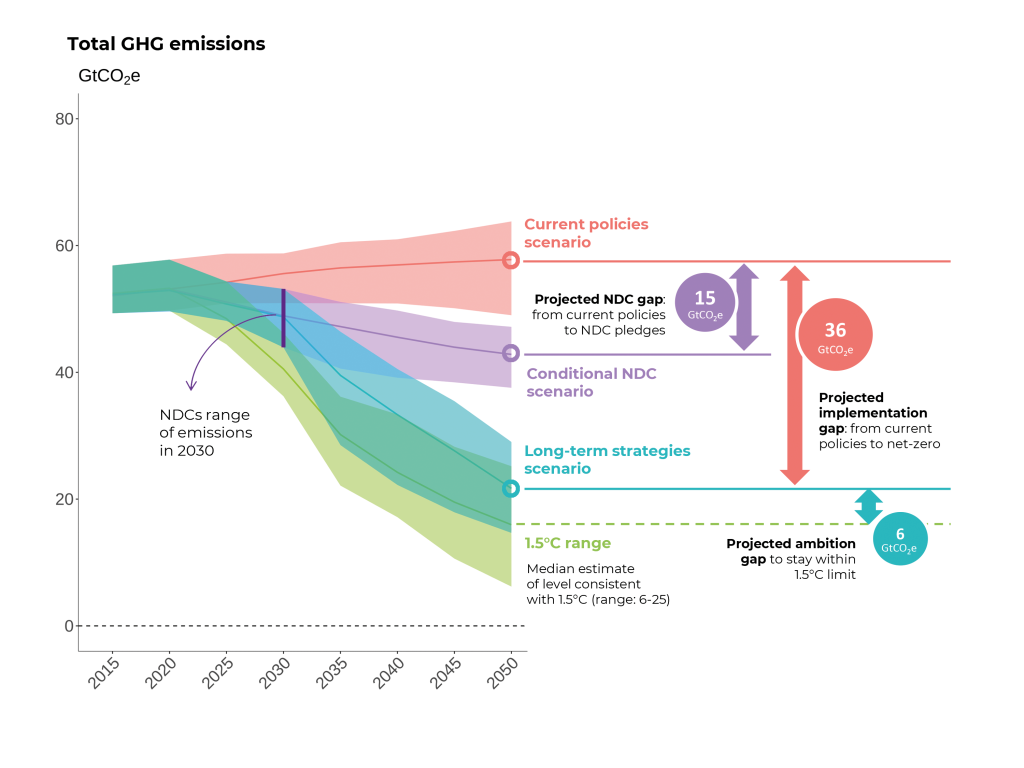Emission gap to net-zero pledges and 1.5 degrees still remains
The Paris agreement implies that greenhouse gas emissions need to be reduced significantly. To limit the temperature increase to 1.5 degrees, global CO2-emissions must reach net-zero around 2050. While in the past few years many countries have made net-zero pledges - a major step forward - the sum of these pledges is still insufficient to reach 1.5 degrees. Moreover, implemented policies are not yet ambitious and concrete enough to move towards the pledges, leaving a sizeable annual emissions gap of around 36 GtCO2-eq by 2050. This is a key conclusion of the ELEVATE Annual Net-Zero Report by PBL Netherlands Environmental Assessment Agency and research partners.
Implementation of current climate policies is not enough to achieve the net-zero targets on a global level — an implementation gap of 36 GtCO₂e still remains by 2050. This amounts to roughly two thirds of total current annual emissions of greenhouse gases. Countries need to significantly increase their ambition levels if they want to achieve their self-imposed targets. Even if all net-zero pledges fully materialize, 1.5 degrees is out of reach: the ambition gap to a 1.5 degrees compatible pathway is projected at 6 GtCO₂e by 2050, revealing that, on a global level, announced net-zero emission projections are not fully aligned with the collective Paris Agreement goals — further effort is still required.

Net-zero CO2 around 2050 required for 1.5 degrees
While global greenhouse gas emissions remain at an all-time high, global CO2 emissions must reach net-zero around 2050 to limit temperature increase to 1.5 degrees and around two decades later to stay well below 2 degrees. Since the COP26 in Glasgow in 2021, many countries have pledged to achieve net-zero emissions, mostly by the period 2040-2070, which is a hopeful development. Currently, all these net-zero pledges together cover 80 to 90 percent of global greenhouse gas emissions. The UNEP Emission Gap report looks at the emission gap by 2030 and 2035 based on the so-called Nationally Determined Contributions. The new ELEVATE Annual Net-Zero Report examines the outcomes of climate policies in 2050, when net-zero CO2 would actually need to be reached.
Net-zero pledges need to be clarified further
Many net-zero pledges lack important information relating to their implementation strategy - making it unclear whether they will be met, and increasing uncertainty of future emission trajectories. Certain net-zero pledges do not even specify which greenhouse gases are covered by it. This is problematic as net-zero emissions for CO2 are usually reached much earlier than net-zero emissions for all greenhouse gases. Additionally, while 40 percent of countries have enshrined their net-zero targets in policies or law, over a third of the countries have no concrete plan on how to realize their pledges. In most 1.5 and 2 degrees scenarios emissions peak between 2020 and 2025, followed by a sustained downwards emissions trajectory to net-zero. This means that if net-zero pledges are not implemented immediately , more negative emissions are needed later in the century to reach a given target.
Most countries are not on track
The ELEVATE Annual Net-Zero Report captures the remaining emission gaps for five major emitters: the EU-27, the USA, China, India and Brazil. While the EU-27 net-zero emission target has a clear structure, transparency, scope, analysis and a legal framework supporting the target, the EU-27 could still miss its 2030 target of 55 percent emission reduction from 1990 levels when policies of individual member states are considered. USA policies for 2030 are well aligned with meeting its net-zero target by 2050, but there is high uncertainty regarding the rate of decline. For China, India and Brazil, meeting their net-zero targets requires additional effort.
Open source online tool to explore national target
One of the major issues at the COP28 in Dubai is how much individual countries need to contribute to emission reductions: which share of the remaining global carbon budget can any country reasonably claim? What is a fair distribution? Commonly proposed principles concern fairness and equality (equal per capita allocation), responsibility (including historical emissions) and capability (which country is most capable in terms of wealth and institutions), while other commonly proposed principles are grand fathering (everyone reduces equal shares of their current emissions) and cost optimality (where do climate policies cost the least?). To show the outcomes of using different combinations of these equity principles for varying climate scenarios, PBL Environmental Assessment Agency and the Netherlands eScience Center have developed a free open source online tool: The Carbon Budget Explorer (beta version until December). The dashboard aims to create transparency and insight for policymakers, scientists and the generals public. Next year the ELEVATE Annual Net-Zero Report will focus specifically on justice and fairness.
Elevate
In the ELEVATE project, climate policy research institutes from many countries in the world, including the USA, China, India, Brazil and Europe, collaborate to evaluate current international climate policy and suggest possible new policies to reach the goals of the Paris Climate Agreement. ELEVATE is funded by the European Horizon Europe programme.
- Nieuws | 4 December 2023to the publication on the PBL website